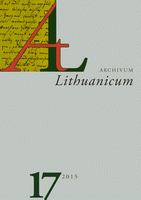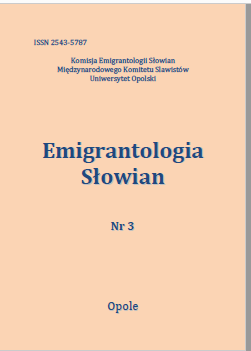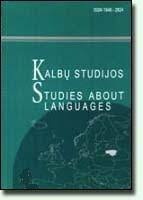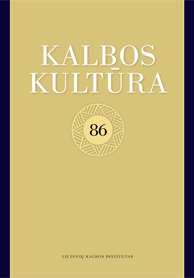
We kindly inform you that, as long as the subject affiliation of our 300.000+ articles is in progress, you might get unsufficient or no results on your third level or second level search. In this case, please broaden your search criteria.


In the article an attempt to describe the oldest Western Ruthenian dictionary has been made. The analysis is based on the following texts: 1) Лексисъ с толкованiемъ словенскихъ мовъ просто of the first part of the 16th century, 2) Лексис Сирhчъ Речeн¿#, Въкрaтъцh събрaн(ъ)ны. И iз слове(н)скаго “зыка, напросты(й) Рuскiй Дi#ле(к)тъ Истол(ъ)кованы Л,З by L. Zizaniy (Vilno 1596), 3) Лексiконъ славеноросскiй i именъ тлъкованiе by P. Berynda (Kiev 1627), 4) Синонима славеноросcкая (the end of the 17th century). The focus of attention is directed to lexicographic specificity of the antique texts, the elements of their macro- and microstructures, sources and techniques of material documentation, which made it possible to observe the evolution of lexicographers` methodological procedure in the range of the structure of an entry, e.g.: efforts to introduce grammatical information, qualifiers (mostly etymological and stylistic), and material exemplification. Dictionaries, which were essentially used to learn the language of liturgical celebration, contained religious vocabulary. It should be noted, however, that their authors introduced Ruthenian words of various thematic groups and stylistic registers to the translated parts of lexicons. In Berynda`s dictionary Polish loan words appeared as entries.
More...
The article deals with the antonymic terms which were extracted from important works on the theory of literature and history of universal literature published in 1922–1942. That period is an important stage of the development of present-day Lithuanian terminology of literary science. The sources of the article are following: Literatūros teorija (The Theory of Literature) (1922) by K. Bizauskas, Stilistika (Stylistics) (1927) by M. Gustaitis, Literatūros teorija (The Theory of Literature) (1930) by J. Norkus, Įvadas į bendrąją literatūrą (An Introduction to Universal Literature) (1923) and Literatūros įvadas (An Introduction to Literature) (1931) by V. Dubas, Visuotinė literatūra (Universal Literature) (1942, 2 volumes) by J. Ambrazevičius, J. Grinius, A. Vaičiulaitis. Not only “real” literary terms (tragedija ‘tragedy‘ – komedija ‘comedy’) are antonymous, but also general terms of science and art (indukcija ‘induction’ – dedukcija ‘deduction’; realus fonas ‘realistic background’ – fantastinis fonas ‘fantastic background’) and some terms of related subject fields such as linguistics (ilgas skiemuo ‘long syllable’ – trumpas skiemuo ‘short syllable’), aesthetics (grožybė ‘beauty’ – biaurybė ‘nasty’) etc which make the integral part of literary science. In respect of meaning, antonymic literary terms belong to different groups of terms, for instance, names of features, names of the means of expression, names of the elements of text, names of the parts of writings, names of actions etc.According to expression, antonymic literary terms are either conjugate terms (derivational antonyms) (eiliuotinis epas ‘poetical epos’ – neeiliuotinis epas ‘non-poetical epos’) or non-conjugate ones (lexical antonyms) (turinys ‘content’ – forma ‘form’). Antonyms (as well as antonymic terms with opposite elements) are of the similar origin (Lithuanian or foreign) or even of the mixed origin. Terms with Lithuanian opposite elements apparently dominate in the group of derivational antonyms. Therefore the foundations of antonymy of terms are dichotomy principle and binary concepts, investigated antonymic terms more frequently are connected by contradictory opposite (originalas ‘original’ – vertimas ‘translation’) than contrary opposite (užuomazga ‘entanglement’ – atomazga ‘denouement’), vector (directional) opposite (veiksmo kilimas ‘rise of action’ – veiksmo slūgimas ‘fall of action’) or converse opposite (klausimas ‘question’ – atsakymas ‘answer’).Terminology of literary science of the investigated textbooks has not only its own antonyms (such as poezija ‘poetry’ – proza ‘prose’), which have got into common (non-terminological) usage, but also antonyms opposition of which is related with particular antonymy of general lexis (tikrovė ‘reality’ – prasimanymas ‘fiction’). Antonymy of some complex terms is based on antonymy of one-word terms (or their relatives) (compare: poezija – proza → poezijos veikalas ‘poetic work (writing) ’ – prozos veikalas ‘prosaic work (writing) ’), sometimes opposite lies with antonymy of general lexis (gerasis veikėjas ‘positive personage’ – blogasis veikėjas ‘negative personage’). Attention should be drawn to the fact that terms which had been created with antonyms of general lexis may not always be considered as antonyms (compare vyriškas ‘masculine’ – moteriškas ‘feminine’ and vyriškas rimas ‘masculine rhyme’ – moteriškas rimas ‘feminine rhyme’).Amongst investigated antonyms complex terms make up the largest group and complex antonyms with antonymic subordinate elements are more numerous than antonyms with antonymic main elements. This may be caused mostly by a non-linguistic factor – particular system of concepts.Some groups of pairs of antonyms are visible in the investigated material. Those groups consist of key (basic) literary antonyms and terms related with them, for example: poezija ‘poetry’ – proza ‘prose’, poezijos x – prozos x, poetinis x – prozinis x, poetiškas x – proziškas x (‘poetic’ x – ‘prosaic’ x); tragedija ‘tragedy’ – komedija ‘comedy’, tragizmas ‘tragedy’ – komizmas ‘comicality’, traginis x – kominis x, tragiškas x – komiškas x (‘tragic’ x – ‘comic’ x) etc.Significant changes of antonymy of literary terms during investigated 20 years period haven’t been noticed. Surely, over time one or another variant or synonym of antonymic term was chosen or opposite concepts were named by the whole other pair of antonymic terms. However the antonymy itself is constant semantic relation.
More...
The article deals with the terminographical aspect of the first Lithuanian dictionary of law compiled in Lithuania – manuscript Teisės terminų ir kitų reikalingų teismams žodžių žodynėlio projektas (Draft dictionary of law terms and other words necessary for courts) (1920). The dictionary was prepared by the Ministry of Justice; its main compiler was, most likely, Konstantinas Jablonskis. A number of copies of this manuscript were made, therefore a few of them have survived. This is quite a large translative Russian–Lithuanian dictionary comprising 120 pages. It has a mixed structure – terms (including other lexical and syntactic units) are presented either in separate entries or grouped into a single entry according to some common feature. The dictionary presents diverse material – terms, words and their combinations used in the language of law at that time. Grammatical expression of the data also varies – nouns, adjectives, verbs and other parts of speech are included. Some Russian terms (285 entries) were not translated, though in general the data is rich – there are nearly 3900 different entries with Lithuanian equivalents.The article describes the macro and microstructure of the dictionary, the grammatical and structural types of the data. The dictionary is not particularly well thoughtout, neither is it systematically arranged and some repetition of the data can be found. Still it has to be taken into consideration that it was compiled at a time when there was no terminographical tradition in Lithuania (there were few dictionaries of terms published); therefore its faults shouldn’t be judged strictly. This dictionary is a valuable object for the history of Lithuanian terminography.
More...
The article deals with folk terminology of farm buildings in respect of concepts, origin and semantic relations. The researched terms are taken from various lexicographical sources of Lithuanian folk terminology. There are 196 terms in the researched sources which name 54 different farm buildings. The majority of the terms are of Lithuanian origin, they make up nearly two thirds (64%) of all terms researched, for example klėtis (granary) ‘building for storing grain or clothes’, kluonas ‘building for storing, drying and threshing cereal’, daržinė ‘building for storing hay’. Borrowings from Slavic and Germanic languages as well as the Latvian language make up one fifth (20%), for example pavietis (Belarus. павец) ‘building for storing hay’, staldas (Germ. dial. stall) ‘building for keeping animals’, reja (Latv. rija) ‘building for storing and drying cereal’. Hybrids and terms with mixed composition, for example stojinė (Sl. stoinia and Lith. -inė) ‘building for keeping horses’, karvinis (Lith.) staldas (Germ. dial. stall) make one sixth (16%) of all terms researched.
More...
In the Purpura manuscript (approximately the middle of the nineteenth century), written in the North Lowland (Žemaičiai) dialect, all Polish vowel letters are used to denote monophthongs (except for Ó ó, so-called <o> kreskowane The graphemes A a, E e only occasionally express the long vowels [a∙], [e∙]: most often they are replaced by ai, ei or aj, ej type digraphs; hypercorrect forms are frequent in definite forms of adjectives: [a∙], [e∙] → aj, ej and so forth. The characters Ą ą, Ę ę mark both long nasal mid vowels, that originate from *, * (← *an, *en), and optional nasal allophones of /ọ/, /ẹ/ phonemes: denasalization of phonemes is a rather late alteration. I i that mark the high vowel [i] in flexion were well differentiated from Y y which denote the mid vowel [ẹ] according to the tradition. In absolute word initial position, however, the letters I i are written instead of expected Y y (with certain rare exceptions): apparently graphic neutralization of <y> ↔ <i> → <i> / #— takes place; the lack of Y y in word initial position in Polish orthography explains this. The letter y [ẹ] happens to be written also in unaccentable word medial position and in unaccented endings in cases where Žyvatas (Ziwatas, 1759) very consistently had e [e]. The phonetic value of the polyfunctional letter U u of Žyvatas and of many other North Lowland dialect texts was successfully divided into two: U u and O o. The attribution of new additional phonetic value to the graphemes O o (along with the main value O o [uo]) enabled separation of the mid vowels [ọ], [ọ.] from the high vowels [u], [u.], that were marked by the traditional symbols U u.
More...
Der vorliegende Aufsatz widmet sich der Identifizierung einer weiteren Quelle des handschriftlichen deutsch-litauischen Wörterbuches Clavis Germanico-Lithvana (im Folgenden als C bezeichnet). Hier wurde der Frage nachgegangen, ob das deutsch-lateinische Wörterbuch Clavis Germanico-Latina (im Folgenden als Cla bezeichnet) – es handelt sich dabei um den zweiten Teil der Clavis Linguæ Latinæ von Johann Jacob Dentzler, die seit 1666 bis zum Anfang des 18. Jh. in zahlreichen Auflagen (1667, 1677, 1686, 1697, 1706, 1708, 1709, 1713, 1715, 1716) erschienen ist – möglicherweise als Vorlage für C gedient hat. Zu diesem Zweck wurde eine vergleichende Analyse der Makro- und Mikrostruktur der beiden Wörterbücher durchgeführt. Die Analyse von C und Cla hat eine Reihe von Anhaltspunkten ergeben, die Cla als Quelle von C vermuten lässt. Die Gestaltung und der Aufbau von C und Cla (der metaphorische Titel mit dem lateinischen Wort Clavis [dt. Schlüssel], die graphische Gestaltung des Titels, zweibuchstabige Überschriften am Anfang jeder Seite) deuten darauf hin, dass Cla als Vorbild für den Kompilator von C gedient hat. Übereinstimende Lemmata, die nicht in den anderen bekannten Quellen von C (nämlich der Konkordanz zur Lutherbibel von Conrad Agricola [AK] und des durch Lex repräsentierten Prototyps *Lex sowie des durch K und R repräsentierten gemeinsamen Prototypen *KR bzw. dessen Varianten *KR1 ir *KR2) zu finden sind, manche ihrer deutschen Synonyme und in besonderem Maße die lateinischen Entsprechungen legen ebenso die Annahme nahe, dass einige Elemente der Makro- wie der Mikrostruktur von C aus Cla übernommen wurden.
More...
Die Bibelübersetzung des Johannes Bretke (lit. Jonas Bretkūnas, 1536–1602) ist eines der umfangreichsten Zeugnisse preußisch-litauischer Literatur. Noch heute, über 400 Jahre nach dem Tod des Übersetzers, sind die meisten Teile des Werks unediert, lediglich der Psalter wurde 2002 von Friedrich Scholz herausgegeben, die Edition der Evangelien und der Apostelgeschichte ist bis heute unveröffentlicht.
More...
Mit Nehrungskurisch wird in der deutschsprachigen sprachwissenschaftlichen Literatur die auf kurländisch-lettischen Dialekten basierende Sprache bezeichnet, die von den Bewohnern – in erster Linie Fischern – auf der Kurischen Nehrung und daran angrenzenden Gebieten bis ca. 1958 gesprochen wurde. In der litauischsprachigen Literatur hat sich dafür der Terminus kuršininkų kalba bzw. kuršininkų tarmė, in der lettischen – kursenieku valoda eingebürgert.
More...
The aim of the research: the article deals with study of modern Dagestan city linguistic landscape. The relevance of the research: the relevance of the chosen topic is explained by the need for a synchronous description and analysis of toponymic, cultural-historical, linguistic, cultural, ethnolinguistic, and sociolinguistic traditions and representations of a complex and multi-level toponymic system on the example of one Dagestan city - the capital of the Republic - Makhachkala. It is a unique phenomenon of Russian and Dagestan linguistic cultures mix, which united into a single one. Research methods: the scientific research paper considers the basic principles of urbanonyms’ nomination, the most frequent word-building patterns of both official and unofficial names of urban objects and microtoponyms of present and past. The specifics of the post-Soviet Dagestan city linguistic landscape have been revealed as its shows socio-political, economic, cultural and ideological tendencies of different periods of Russian history. Toponyms are considered not only from the perspective of structural, semantic and functional aspects, but also from the point of cognition. Special attention is paid to ergonyms as a significant part of urbanization. The conditions its creation and successful functioning are indicated. Results: the analysis of the linguistic landscape of Makhachkala has revealed universal and specific mechanisms of toponyms composition, reflecting the peculiarities of regional mentality. This is a diverse, often inconsistent linguistic practice of Russian, English and Dagestan languages usage, which shows us the multi-language and socio-cultural chronotope of the city. The area of the pragmatics of languages functioning is determined by the socio-political and economic factors, which influence on the initially polylingual Makhachkala. Significance of the research: the further prospects of research are observation and changes analysis of modern Dagestan city in the linguistic landscape of the modern Dagestan city. It will allow us to understand more deeply the sociolinguistic processes in the polyethnic Russian society.
More...
Old-Believers, who were escaping from persecutions, started moving towards the western neighbours of Russia. They set up their settlements in The Grand Duchy of Lithuania (Lithuania, Belarus), Livonia (Latgale) and on the western shore of the lake Peipus. The lexis of the displaced people was influenced by numerous borrowings through centuries. We can observe many synonyms of the elements of the native and foreign vocabulary. The article presents typical features common for the five enclaves of the Old-Believers in Belarus, Lithuania, Latvia, Poland and Estonia. The analysis of the features is based on the material excerpted from dictionaries of the Old-Believers' dialects.
More...
The grammatical and semantic systems of noun categories are undergoing obvious changes in modern Latvian. The most vivid example of such change is in the category of case and it’s semantic structure. There is a concurrence between case forms for different syntactic functions, e.g., for negation G//N ‘makā nav naudas//nauda’/‘there is no money in the wallet’; in debitive construction (these constructions express necessity in Latvian, e.g., Man ir jālasa grāmata ‘I must read a book’. Debitive belongs to the system of moods in Latvian) N//A ‘man ir jālasa grāmata//grāmatu’/‘I must read a book’; and for a negated direct object G//A ‘neteikšu neviena vārda//vārdu’/‘I’ll not say a word’.
More...
Straipsnyje nagrinėjamas mokslinės kalbos vertimo kompetencijos ugdymas, remiantis išsamia dviejų kalbų lingvistine lyginamąja analize. Mokydamiesi užsienio kalbos, studentai jau turi susiformavusią lingvistinę gimtosios kalbos patirtį; susidūrę su svetima kalba, perkelia turimą patirtį ir atvirkščiai – šį tą skolinasi iš svetimosios kalbos. Taip pat vyksta kalbų interferencija. Straipsnyje daug dėmesio skiriama mokslinės terminijos interferencijos problemoms. Taip pat pateikiama lyginamoji ekonominės terminijos struktūrinė semantinė analizė. Šios analizės tikslas – nustatyti lietuvių ir rusų kalbų ekonominės terminijos gramatinių kategorijų ir semantikos panašumus ir skirtumus. Tai leidžia išryškinti šios terminijos vartojimo sunkumus ir padės tikslingai ir kryptingai organizuoti mokymą.
More...
Using quantitative and qualitative approaches alongside contrastive analysis, this paper investigates distribution frequency and functions of reformulation markers employed in academic discourse in two languages (English and Lithuanian) and three science fields (humanities, medicine, technology). The English language data is taken from the academic language sub-corpus of the Corpus of Contemporary American English, while the Lithuanian language data comes from the Corpus Academicum Lithuanicum, a specialised synchronic corpus of written academic Lithuanian. The results show that it is the humanities scholars who employ reformulation markers most frequently in both languages. They also employ a wider range of reformulation markers and use them in more diverse ways than scholars in the hard fields. The most frequent function of reformulation markers irrespective of language and science field is the interpretation of explicit content. The analysis highlights the importance of the discipline and genre in the distribution and use of reformulation markers.
More...
Review of: IWоBA VIII (International Workshop on Balto-Slavic Accentology) – Referati VIII međunarodnog skupa o baltoslovenskoj akcentologiji (Novi Sad, 6–8 jul 2012), Slavistički zbornik (2014), Radmilo Marojević (ur.), Novi Sad: Biblioteka Matice srpske – Filozofski fakultet.
More...
The term reflexivity names a formal feature that unites a lexical grammatical group of reflexive verbs. The aim of the research is to find out the terms used in various Latvian and Lithuanian sources, such as dictionaries, grammar books, scientific and instructional literature, to describe such verbs and verb-building. Two compound terms of different origin are popular in the works of Latvian linguistics: a three-word term of own language, atgriezeniskais darbības vārds, or a two-word term of foreign origin, refleksīvais verbs ‘reflexive verb’, (to note, endings of a secondary component can be both pronominal and non-pronominal in practice). In Lithuanian, such verbs are also called by synonymous compound terms encompassing a secondary component of different origin: sangrąžinis veiksmažodis and refleksyvinis veiksmažodis ‘reflexive verb’. The descriptions of reflexive verbs demonstrate the diversity of the terms to name the means that built them. In Latvian, atgriezeniskā galotne ‘reflexive ending’, is the most frequently used term; however, the sources display other ones, too: atgriezeniskais afikss ‘reflexive affix’, atgriezeniskais formants ‘reflexive formant, reflexive formative’, atgriezeniskā morfēma etc. In Lithuanian, this notion is named by the terms sangrąžos dalelytė ‘reflexive particle’ (cf. dalelytė in Latvian grammar terminology corresponds with a term partikula, ‘particle’) and sangrąžos afiksas ‘reflexive affix’. It was observed that the character of a formant or the position of it is emphasised in both languages, for example, in Latvian there is postpozitīvs formants ‘postpositive formant’, and in Lithuanian there is galinė morfema ‘end morpheme’, postfleksinė pozicija ‘post-flexion position’. The comparison revealed that the terms naming distribution of verbs into non-reflexive (in Latvian such verbs are called using a term tiešie ‘direct verb*’ (in the Dictionary of Latvian Terms it is given with an asterisk because it is a word-for-word translation, perhaps, there is no tradition in the English language)), and reflexive (in Latvian they are called atgriezeniskie ‘reflexive’) differed.
More...
In our paper we describe a specific, Latvian two-word construction consisting of a verb preceded by an adverb derived from the same verb by the suffix -in-/-tin- (e.g. bērtin bērt). We are interested in how a given language element, apparently archaic and typical of Latvian folk songs (dainas), is used in today’s language. Some research questions are articulated, including one that goes beyond the specific realm of the Latvian language (how can these constructions be translated into other languages?). We search for the construction in the available Latvian corpora (LVK2018, lvTenTen14, InterCorp lv v11, Rainis and SENIE) and compare the resulting occurrences with a description in the current Latvian linguistic sources: both grammars and dictionaries. Deviations from the norm are treated descriptively in this article, as the speakers’ aim is to achieve a communication goal rather than their mistakes, as well as the creative development of this construction up to the present. The article is supplemented with an appendix: alphabetic lists of analysed lemmas along with their frequency.
More...
The article deals with the compound constructional terms in scientific literature, published between 1918 and 1940. In Lithuania, during the interwar period, the construction sector was rapidly expanding, there were many new realities, which called for many new terms, including compounds. Exclusive personalities were very important for the development of construction terms of this period and for the formation of this professional language: Kazimieras Vasiliauskas, Jonas Šimoliūnas, Pranas Morkūnas, Anatolijus Rozenbliumas, Pranas Jodele, Jonas Kiškinas, Juozas Gabrys and others. Not only did these construction engineers carry out significant research, writing articles and books, teaching young people, but also enriched construction terminology. Quantitative data of related terms from 33 scientific papers and articles on construction indicate that during the interwar period compounding was an important way of developing construction terms: in the literature read, 262 related compound terms were found. The German equivalents presented in addition to some of the compounds make the assumption that the Lithuanian compounds are to be regarded as partial or full evaluations. Although general types of Lithuanian compound terms are characterized by the same major types of compounding found in the the present Lithuanian language, analyzing the period from 1918 to 1940 construction terminology compounds, it is determined that they are made according to 10 types of production.
More...
The article analyses common names of human genitals used by Lithuanian medical doctors in the popularized medical writings (books, booklets and articles) of the late 19th and early 20th centuries. The meanings of these names are identified based on the context of their use and other sources (the Academic Dictionary of the Lithuanian Language, anatomy literature), and the etymological sources are determined (colloquial, written and foreign languages). Questions of the relationship between endogenous and exogenous terms, creation of new terms, problematic meanings of some terms, connotations, terminologization, and euphemization are discussed.
More...
Review of: Jolanta Gaivenytė-Butler - Aiškinamasis dietologijos terminų žodynėlis / Laisvūnė Petkevičienė. – Vilnius: Homo liber, 2018. – 47, [1] p. – Bibliogr.: p. 43–44; Kn. taip pat: Pratarmė / Rimantas Stukas, apie autorę / Erika Kubilienė, p. 45–47. – Tiražas 200 egz. – ISBN 978-609-446-176-7. Jolanta Gaivenytė-Butler - Aiškinamasis maitinimo įmonių terminų lietuvių–anglų kalbų žodynas / Marija Jonikienė. – Vilnius: Homo liber, 20181. – 164 p. – Tiražas 200 egz. – ISBN 978-609-446-159-0. Jolanta Gaivenytė-Butler - Aiškinamasis miškininkystės terminų žodynas = Лесохозяй-ственный словарь = Forstwirtschaftliches Fachwörterbuch = Dictionary of forestry: (lietuvių–rusų–vokiečių–anglų k. su lotyniškais botanikos, zoologijos ir miško tipologijos terminų vardais) / Leonardas A. Kairiūkštis; [Lietuvos mokslų akademija, Lietuvos agrarinių ir miškų mokslų centro filialas Miškų institutas, Lietuvos miško ir žemės savininkų asociacija]. – Kaunas: Lututė, 2018. – 736 p. – Bibliogr.: p. 25–32; r-klės: p. 488– 735. – Tiražas [1000] egz. – ISBN 978-9955-37-203-5 (įr.). Jolanta Gaivenytė-Butler - Aiškinamasis projektų valdymo terminų žodynas / Vytautas Būda; ISM Vadybos ir ekonomikos universitetas, Lietuvos projektų vadybos asociacija. – 2-asis patais. leid. – Vilnius: Mokslo ir enciklopedijų leidybos centras, 2018. – 166, [1] p. – Bibliogr.: p. 164–166 (55 pavad.); Lietuvių–anglų terminų r-klė: p. 116–157. – Tiražas 500 egz. – ISBN 978-5-420-01770-8 (klaidingas). Jolanta Gaivenytė-Butler - Aiškinamasis ryšių su visuomene terminų žodynas [elektroninis išteklius] / Toma Lipskytė (grupės vadovė), Renata Matkevičienė, Orinta Barkauskaitė, Gabija Vaičeliūnaitė, Birutė Norvaišienė; Lietuvos komunikacijos asociacija. – Vilnius, 2018. Jolanta Gaivenytė-Butler - Deutsch–litauisches, litauisch–deutsches Wirtschafts-und Rechtswörterbuch = Vokiečių–lietuvių, lietuvių–vokiečių kalbų verslo ir teisės žodynas / [Yvonne Goldammer, Paulius Jurčys, Sigitas Plaušinaitis]. – Vilnius: Žuvėdra, 2018. – 758, [2] p. – Tiražas [500] egz. – ISBN 978-609-8219-01-2 (įr.). Jolanta Gaivenytė-Butler - Kraštovaizdžio projektuotojo terminų žodynas lietuvių–anglų kalba = Glossary of terms for landscape designer, Lithuanian–English languages / Klaipėdos valstybinė kolegija; [sudarytojos Rita Nekrošienė, Regina Repšienė, Jurga Kučinskienė, Vida Gerikienė, Diana Baravykaitė, Regina Malakauskienė, Reda Tamelienė, Elena Moščenkova, Inga Benetienė]. – Kaunas: [Vitae Litera], 2018. – 169, [1] p. – Bibliogr.: p. 166–167 (25 pavad.); Terminų r-klė: p. 108–137. – Tiražas 50 egz. –ISBN 978-609-454-368-5.
More...